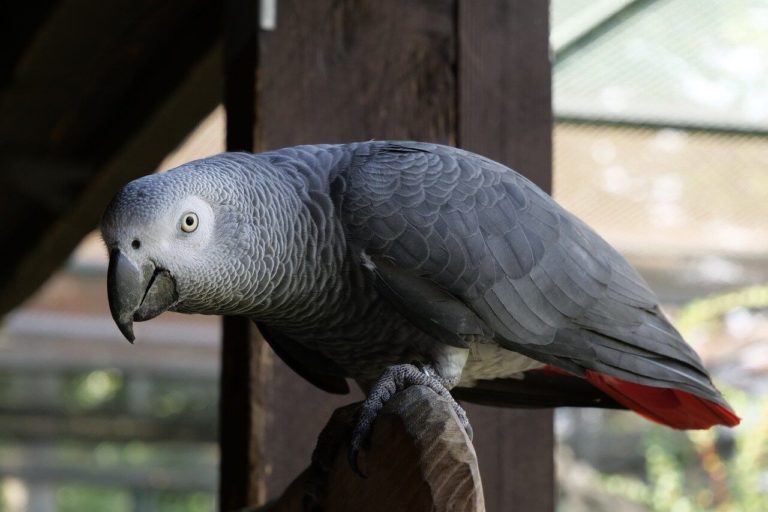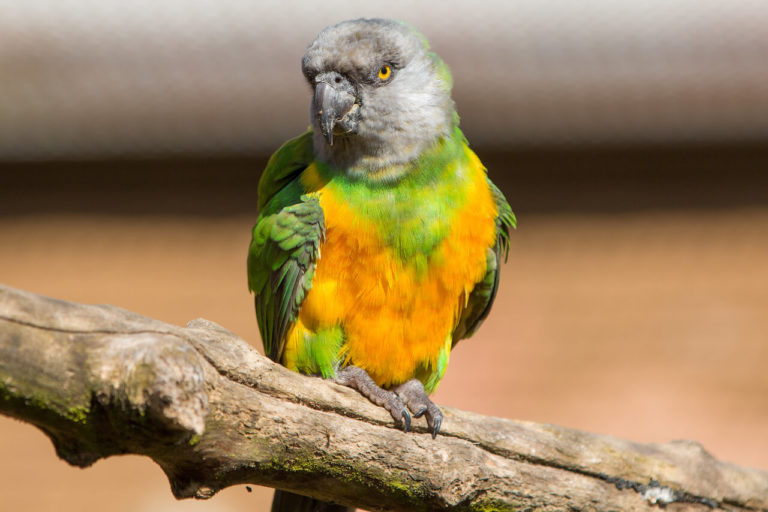






As the name suggests, this pretty bird originally came from the Canary Islands. About 500 years ago the first specimens came to the mainland, where they were further bred in the following centuries. Meanwhile, the canary exists in several breeds and many colors. After the budgie, it has become the most popular home bird.
Canaries are known for their persistent song, which is much more pronounced in the male than in the female. The diurnal birds are characterized especially by their round head and pointed short beaks, which taper cone-shaped.
Cage
Since canaries have a great urge to move, an aviary (i.e. a cage with plenty of flight space) is recommended. An outdoor aviary in the garden is particularly suitable here. The birds are robust and can tolerate winter temperatures. However, an additional birdhouse is useful so that they are not exposed to drafts and can retreat at any time.
The great advantage of an outdoor aviary is that the cage does not take up space in the home. Since you cannot offer the birds free flight outside, the aviary should be large enough so that they can fly in the cage without any problems.
An indoor aviary is usually made of wire and metal. You can buy them in different sizes and shapes. Choose a dry place for the aviary without drafts. A canary – pair needs at least 0,5m² (100 x 50 x 50 cm). Also avoids loud noises. Therefore, a place next to stereo or TV is not suitable. The kitchen is also to be avoided with cooking fumes and the subsequent ventilation. An elevated, sunny location with adequate shade is the ideal location for the cage.
Tip: Choose a suitable place before you buy the aviary. This way you can measure the exact dimensions beforehand and you will have the perfect location for your birds.

Equipment
Fill the floor with litter, which can absorb liquid well. Hemp litter, corn meal, sawdust or beech wood granules are particularly suitable for this purpose.
It is important to provide sufficient seating. Canaries need few objects in the aviary. Non-toxic branches, such as maple, birch, beech, elderberry and willow, are best for perches. Plastic and synthetic branches should be avoided. The material is bad for the birds’ health and their uniform structure does not exercise the muscles or wear out the claws. If you have a free flight room, place branches and perches there as well.
The canary loves water and loves to bathe. Therefore, provide occasional bathing facilities on the floor of the aviary.
Feed
Put the food in a bowl on the floor of the cage. Note that you do not place a perch above it, otherwise droppings will settle in the food bowl. The drinking bowl should not be too low, otherwise the animal will see it as a bathing opportunity. You can get a bird feeder in any specialty store.
The canary eats about 15g of food per day. This corresponds to about one third of the body weight. The basis of the feed can be various grains, seeds and seeds (for example, linseed, hemp, millet, wild seeds, lettuce seeds or wild seeds. During molting, birds are especially dependent on protein. So feed this in addition.
Plants can provide variety and freshness in the diet (e.g. dandelion, nettles, mugwort).
Vegetables provide the canary with vitamins. Tomatoes, carrots, spinach, basil and lettuce are suitable for this purpose (in the case of purchased products, pay attention to organic quality, as pesticides and sprays are poisonous and life-threatening for small canary bodies). Likewise, fruit such as apples, pears, berries and bananas are healthy.
Branches and twigs provide fiber. Oak, beech, pine and maple are suitable here. Water should always be available fresh in the cage.
Toxic foods include: avocado, beans, grapefruit, milk, salty foods and sugar.
In addition, your canary needs stomach grit to aid in digestion. Your bird will be very happy about a limestone or a cuttlebone to wipe its beak. However, before you offer your birds a cuttlebone, you should water it for at least 24 hours. If you don’t, it will be too salty and may harm your birds.
Also especially important is enough water. Canaries need about 20% of their body weight in water per day. Drinking water dispensers are best for this, as the water in these dispensers is least likely to become contaminated. Nevertheless, the water must be changed daily by you and the dispenser must be cleaned.
Attitude
With the correct attitude a canary can become approx. 10 – 12 years old. The canary is not a loner. Therefore, you must acquire the animals at least in pairs. In case of groups, it should always be noted that the number of females is higher. Ideal keeping are one male with several females. Even with a large aviary, the birds need free flight in the apartment to exercise their muscles and the wings do not atrophy. You should make sure that all windows and doors are closed so that your bird cannot escape. You should also cover the windows well if you have a free flight in the apartment. Canaries can not see window glass and can seriously injure themselves when they fly against the windows.
The active animals have a strong urge to move. Therefore, they need a lot of space in the aviary or you give them a whole room. Canaries need at least one hour of free flight per day. The longer the better! During free flight, make sure all windows are closed, no poisonous plants are around, and sources of danger such as electrical outlets or exposed power cords have been secured.
Avoid frantic movements. The small birds are very skittish. Canaries should not be kept singly. They are very comfortable as a pair, but they can also be kept as a small flock or with other smaller birds. A few times a week you can also add vitamin drops to the drinking water, so that your canaries are optimally supplied.
Offspring And Breeding
During the mating season the pair formation takes place. A few weeks later the female starts building the nest and lays the eggs. Once the eggs have been placed, the breeding season begins (13-14 days). The female leaves the nest only to drink and to go to the toilet. The male provides her with food.
The offspring leave the nest after about 2 weeks. However, it takes up to 5 weeks until the young are independent and can feed themselves. They learn food procurement from their father. Following the first molt, the animals are sexually mature.
Breeding in canaries is quite simple. Factors that trigger breeding include daylight length, temperature, and food availability. Longer days and warmer temperatures automatically awaken the natural breeding instinct of canaries.
To prevent brooding, replace the laid eggs with a plastic or clay egg. Hens will not notice the difference and will give up after 14 days. It is not recommended to exchange the eggs without replacement. The brooding instinct will then be even stronger and the hen will keep laying new eggs. This represents an extreme effort for her, which can eventually lead to absolute exhaustion.

Tips For Buying
You should have the complete equipment before buying your new feathered friend, so that he can immediately feel comfortable. Going to the breeder is definitely worth it for the canary purchase. Before you decide to buy, observe the offered birds very carefully. Make sure that the birds are very lively, sing beautifully, eatand drink a lot. They should have beautiful, shiny plumage and clear eyes. For a canary you have to pay at a reputable breeder between 20 and 50 €. The price varies depending on the sex of the bird.














4 thoughts on “Canary Bird”